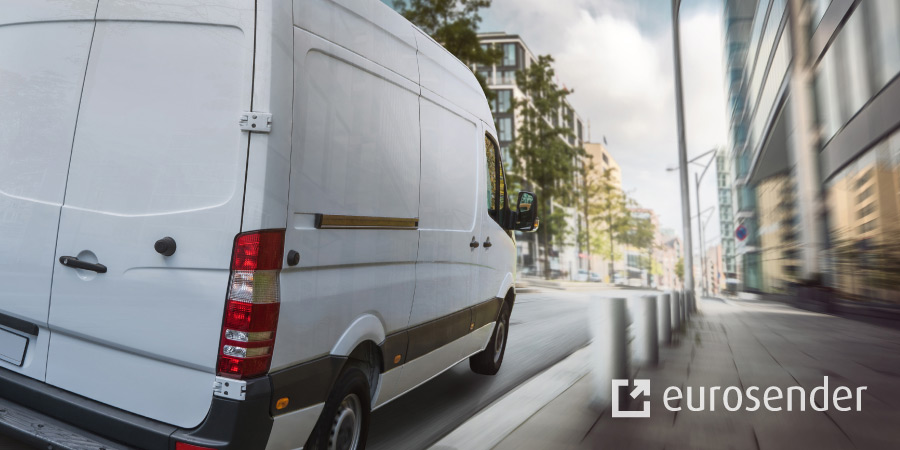Definitions of first-mile, middle-mile and last-mile logistics services
A shipment’s journey from the collection to delivery addresses can be divided into three basic stages:
These are the first, middle and last stages or “miles” in the logistics service supply chain and below we explain the differences between each of them. Find out how you can optimise first, middle and last-mile logistics for your business by choosing Eurosender services.
What is first-mile delivery?
First-mile delivery is the first stage of shipping in which the goods leave the production facility or supplier warehouse. It’s important to understand that the stage from the first mile to the middle mile can have different meanings depending on the industry.
- For retailers, first-mile delivery is the transport of goods from the supplier warehouse to the retailer’s store.
- For e-commerce, the first mile might be the journey of the goods from the retailer to the delivery courier who delivers to the customer’s home, workplace or another pick-up point.
You may be interested to read more about:
Efficient first-mile delivery, for example, same-day collection options for urgent orders, lays the groundwork for a successful shipping experience and, most importantly, a satisfied customer. But this is not all. Your first, middle and final mile delivery stages should each be optimised to create one seamless flow that will benefit your business in the long run.
Read more about:
What is middle-mile delivery?
Middle-mile delivery in most cases means the transfer of goods from a distribution centre to a fulfilment facility. In some cases, there may be several middle-mile delivery stages after the first mile. For this reason, tracking is an important way for the customer and logistics provider to be able to follow the progress and location of the order.
Despite the huge increase in online shopping, e-commerce businesses and other retailers still rely on brick-and-mortar sorting facilities for getting goods processed and delivered to the right customers.
The middle mile delivery stage is actually quite complex because of activities like picking and packing performed “behind the scenes” in the sorting warehouse.
You may be interested to read more about:
There is huge potential for cost saving in the middle mile, as businesses like Amazon have proven. They have been experimenting with innovations such as driverless vehicles and more automated processes for the middle mile. For example, Amazon has purchased their own trucks, warehouses and fulfilment centres. They have also hired workers at a higher rate than competitors, meaning they have more presence in the market.
It is relatively easy to keep costs lower for the middle mile compared to the first or last-mile delivery stages because middle-mile operations tend to become repetitive and predictable. This means that it is easier to automate processes and cut expenses.
Read more about:
What is final mile delivery?
After the first and middle mile stages, last-mile delivery is the final journey of the product to the customer’s doorstep.
This is the most critical stage because it is the “customer-facing” stage of the whole shipping process. It is also the most expensive stage when you take into account labour costs, logistics software and surcharges for failed deliveries.
Customer satisfaction ultimately depends on whether there was a smooth and efficient first-to-the-middle-to-last-mile operation. If the shipment arrives late or damaged, this can ruin the chances of future business collaboration.
Read more about:
What is the difference between the first, middle and last mile?
In first and middle-mile deliveries, the goods are often moved in palletised or crated batches, whereas last-mile deliveries usually involve labelling and transporting individualised goods or SKUs (stock-keeping units) to the final destination.
After going through the first and middle mile stages, the final mile is the delivery to the recipient or end user. If the goods are returned to the retailer, this starts a different process called reverse logistics.
In recent years, many e-commerce businesses and transport companies have focused primarily on the first and last mile problem without considering the middle mile so much or the three stages as a whole.
The problems and challenges faced around the flow of cargo through the first mile and middle mile are similar to what is experienced in last-mile deliveries. But how can Eurosender help you optimise your first, middle and last-mile logistics?
Eurosender services for first, middle and final mile logistics
Having covered the differences between first vs middle vs last mile logistics, it’s time to find the shipping solution that matches your requirements. Our platform offers delivery solutions to businesses and individuals looking for affordable rates with trusted courier services.
You can get instant quotes for almost every courier service we offer. You will always get the most cost-effective solution based on the information you provide during the booking process.
One of the best solutions we offer for optimising first, middle and last-mile logistics altogether is our Van Delivery service. You get a van dedicated to your load only, without any stops or warehouse processing along the way.
If you have particular requirements, you can ask our experts to prepare a tailored service to suit your first, middle or last-mile logistics needs.
Want to know more?
Check our articles that explore different topics within the logistics industry.
